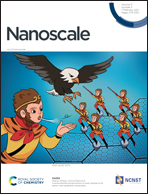Comparative evaluation of MAX-Ti3AlC2 and MXene-Ti3C2 as affinity chromatographic materials for highly selective enrichment of phosphopeptides†
Abstract
MAX and MXene have received considerable attention owing to their outstanding performance in fields like battery and catalysis. However, their possible biomedical applications have rarely been considered, especially the affinity chromatographic applications in proteomics. In this work, considering the large number of exposed metal sites, small binding potential resistance and fast mass transfer speed, layered ternary carbides MAX-Ti3AlC2 and MXene-Ti3C2 with a two-dimensional nanostructure were successfully explored for the first time as affinity chromatography stationary phases for the specific capture of phosphopeptides from complex biological samples. Helium ion microscopy, transmission electron microscopy, atomic force microscopy, X-ray diffraction spectra, X-ray photoelectron spectroscopy and zeta potential measurement results confirmed that the MXene-Ti3C2 was well exfoliated from the pristine MAX-Ti3AlC2. Ti3AlC2 showed better enrichment specificity than MXene-Ti3C2. The detection limit of Ti3AlC2 was as low as 5 fmol. Even when the molar ratio of BSA to β-casein tryptic digests increased to 1000 : 1, two characteristic phosphopeptides with a relatively clear background could be detected after enrichment. After five cycles of repeated use, the enrichment specificity of Ti3AlC2 still remains. Furthermore, 91 and 830 unique phosphopeptides from 23 and 525 phosphoproteins were identified from milk and BEL7402 cells, respectively. Among them, 27 and 170 phosphopeptides, 12 and 56 phosphoproteins identified from milk and BEL7402 cells were not detected with commercial TiO2 after three independent replicates, which have great potential in providing complementary coverage of phosphoproteome. This work opens up new applications of Ti3AlC2 and MXene-Ti3C2, and will play more important role for phosphorylated proteomics in biomedicine.



 Please wait while we load your content...
Please wait while we load your content...